|
BULB LOG 05 1 feb 2005
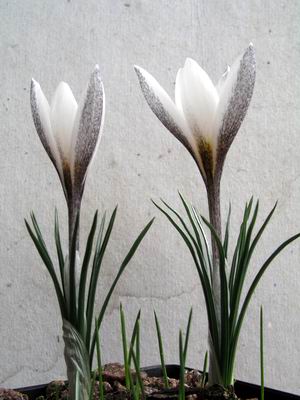
Crocus alatavicus
This is the Crocus alatavicus I showed you in log 03 with its seedlings and now here are its large elegant beautifully marked flowers.
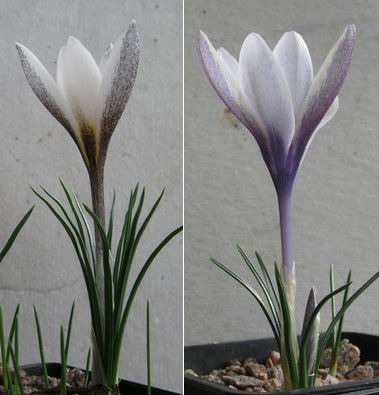
Crocus alatavicus & michelsonii
If you compare it to Crocus michelsonii (on the right), which I also showed in log 03, you can see how closely related these two species are.

Crocus alatvicus compare
Here we can compare that same Crocus alatvicus, on the left, with another form of C. alatvicus that we grow, on the right. This shows just how variable plants can be with one being very desirable while the other, with its smaller flowers, would hardly appear on your wants list. This extreme variation is one of the advantages of raising your bulbs from seed, you can select the most beautiful forms. But, a word of advice, the poor flowered form, on the right, is a good multiplier and makes offsets so it can be bulked up while the beautiful form does not and so can only be increased by seed and there is no guarantee that the seed will result in such nice forms. So we have to evaluatee all the characteristics of a bulb before we select the ones we will hang on to and not just jump for the most attractive form. I have been crossing these two forms in the hope of combining the best qualities from each, to achieve a beautiful flowered form that will also bulk up well.
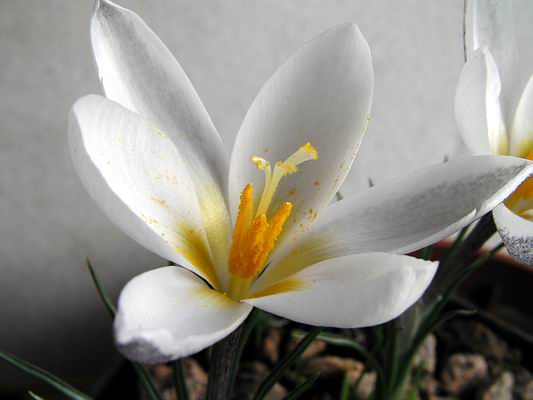
Crocus alatvicus pollen
All of these very early-flowering crocus get the kitchen treatment when we bring them into the warmth of the kitchen so that they will open their flowers, something they are not likely to do in the cold of our un-heated bulb house. We keep them in the warm and watch for the anthers to split open revealing the pollen grains, then with the aid of a fine paint brush I transfer the pollen onto the stigmatic surface on the end of the style. If you find that the pollen does not attach to the hairs of your brush then lick the back of your hand and then run the brush across this moistened area, the brush will pick up just enough moisture to ensure a good collection of pollen. Transferring the pollen between different clones will give the best results but it is still worth doing this even if you only have one flower, as seed will often be produced from a single clone. I always do this pollination several times over the two or three days that the crocuses are in the kitchen.
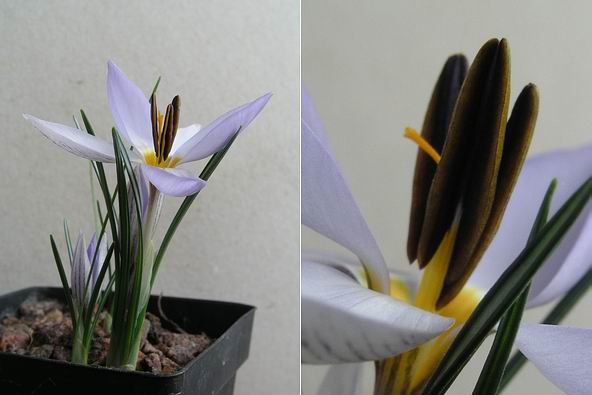
Crocus biflorus nubigena
One of my favourites from the Crocus biflorus complex is the sub species nubigena distinguished by its black anthers. When the anthers split open the pollen is still a golden yellow.
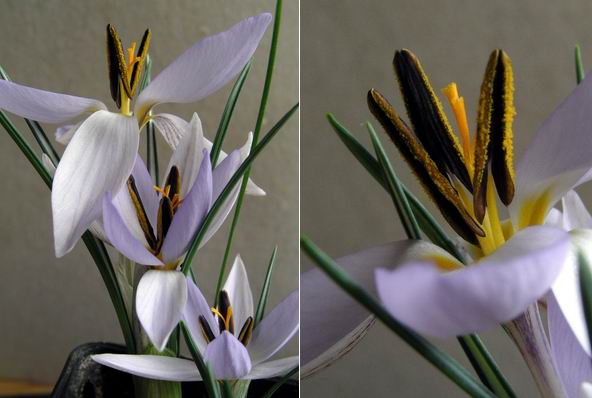
Crocus biflorus nubigena pollen
In the time it has taken me to write this log the anthers of the Crocus biflorus nubigena have dehisced to reveal the yellow pollen, so I could insert this extra picture. When I brought the pot inside just 2 hours ago the flowers were in tight bud.
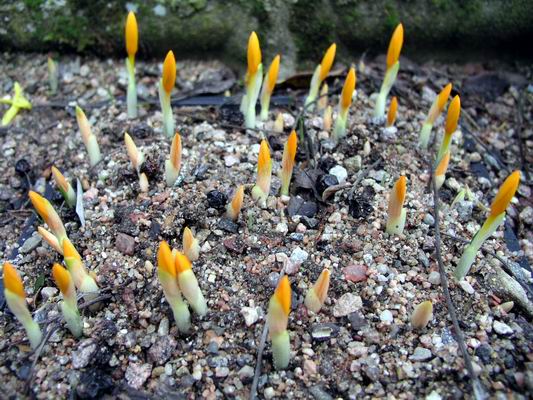
Crocus gargaricus
Crocus gargaricus is pushing through in one of our plunge beds where we try and keep it in a square mesh-pond-basket but there are always some that escape and are now flowering in surrounding baskets. This is why we do not have other crocus species in this plunge bed as we would end up with a fine mixture. Crocus gargaricus likes a moist humus rich soil where it can wander around by stolons, making cheery clumps of egg-yolk yellow flowers in early February.
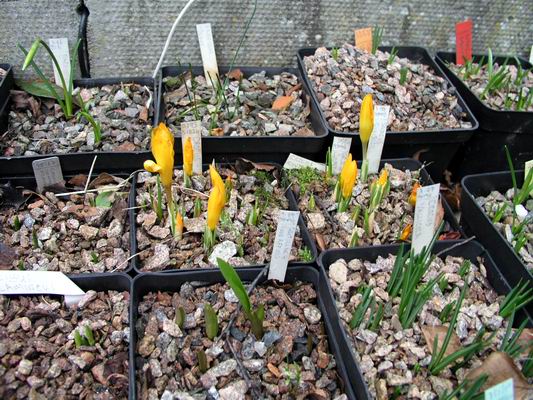
Crocus civijicii
Another of the very intense, early flowering, yellow species, which we grow in both pots in a plunge frame and in a raised bulb bed is Crocus civijicii. I usually move some of the pots under glass in February to get the best of the flowers because if I leave them in the open frame the wind, snow and slugs tend to damage the flowers.
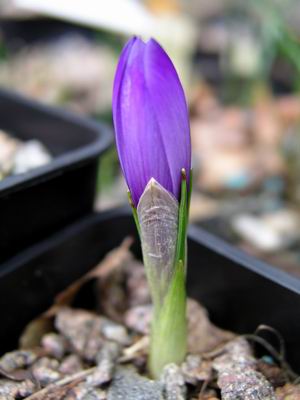
Crocus pelistericus
This Crocus pelistericus flower has popped up much earlier than the others we grow, but again they are seed raised so they will vary in their flowering time. C. civijicii, gargaricus and pelistericus are among the group of species that grow very well for us
in the cooler north while people in the south struggle to keep them going.
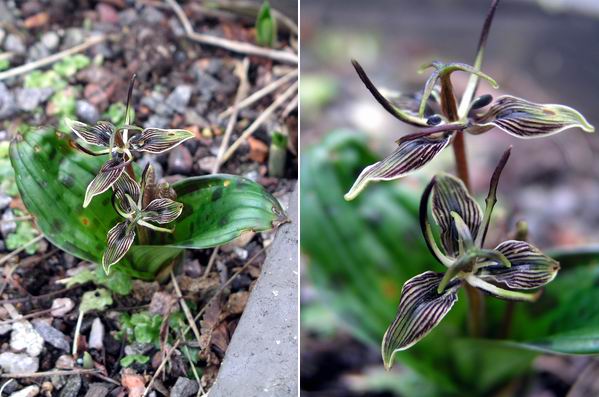
Scoliopus bigelowii
Another plant that likes moisture in the summer is Scoliopus bigelowii. I have had enquires from gardeners in California where Scoliopus grows in the wild, asking how to grow it. Scoliopus has long fleshy roots which sustain the small growth point through the summer months when it is dormant and if these roots shrivel up completely from being too hot and dry then the plant will have to make new roots again before it can think of making a flower, that is, if it survives the hot drought at all. So even though the impression that the natural habitat gives is of a hot dry climate, the deep roots of the plant are in a cool moist condition all through the summer dormancy. We get the first flowers in late December and it will flower through to April, again from seed raised plants. The best flowers will be on the ones that flower later when the weather has warmed up a bit and so they are less likely to be damaged by the cold and wind like those pictured above.
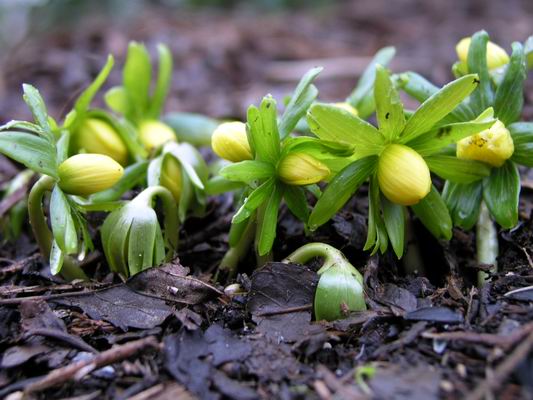
Eranthis appears
It is just as well that I spread the mulch on some of the beds the other week as these Eranthis have just appeared and it will not be long before these spring beds are full of flower.
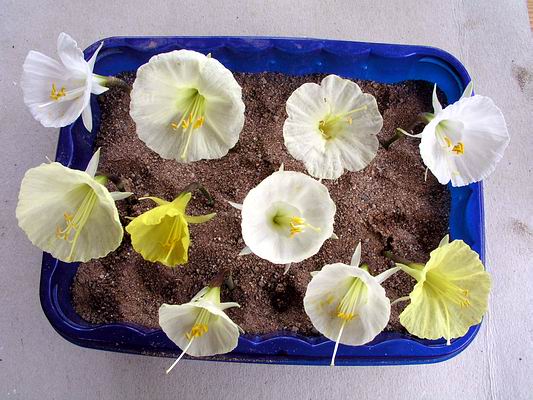 Narcissus romieuxii compare Narcissus romieuxii compare
Do you remember I was complaining about not being able to capture the intense yellow colour of some forms of Narcissus romieuxii? Well, I have been thinking about the problem and come up with this solution. It directly compares just a small number of the different forms that we grow and it does show the colour range from yellow to white. It does mean that I have had to pick a few flowers and will not get seed from them but we do have several hundred others and it makes a nice wee posy for the kitchen!
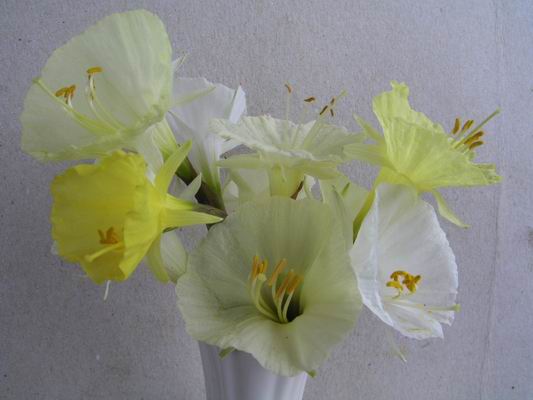
Narcissus romieuxii types
^ back to the top ^
|

